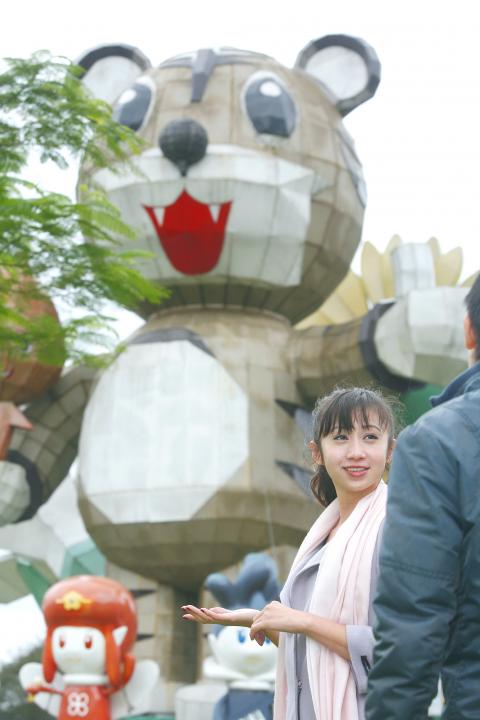The Taipei Lantern Festival has been held for 10 years. When the 10-day festival is over, the main lantern — which is made in the shape of the zodiac animal for the current year — will most likely be disassembled and recycled as garbage. Statistics compiled by a Taipei City councilor suggest that more than NT$60 million has been spent on main lanterns in just the past five years.
The Taipei City Government’s Department of Civil Affairs said that at the end of the festival each year, businesses are given the opportunity to “adopt” the main lantern, but due to high disassembly, transportation and maintenance costs, companies give up on the idea after their evaluation. The civil affairs department has considered putting the lanterns along the riverside, but the Water-Conservancy Act doesn’t allow it. In recent years, every attempt has been made to make the main lantern out of environmentally friendly materials, and it is then placed at the entrance of the Ziqiang Tunnel so that it can be exhibited for at least another year before being recycled.
The Taipei Lantern Festival was first held in 2001. The city’s civil affairs department raises funds from private enterprise and the average budget is between NT$70 million to NT$80 million every year. Statistics provided by Democratic Progressive Party (DPP) Taipei City Councilor Hsu Shu-hua show that the main festival lantern accounts for the largest part of the budget. Every year, the civil affairs department stresses the need to be more environmentally friendly, but they don’t hesitate to spend money, and their vows to promote energy saving and environmental protection become empty slogans.

Photo: Liu Rong, Liberty Times 自由時報記者劉榮攝
Using the Auspicious Tiger, the main lantern from the festival last year, the year of the tiger, as an example, it was installed at the Dazhi entrance to the Ziqiang Tunnel for “reuse.” As the year of the tiger is over, the Baby Rabbit, this year’s main lantern, will be placed at the same spot at the end of the current festival. The Auspicious Tiger, which cost more than NT$17 million, will soon be dismantled and sold as scrap iron.
Hsu said she proposed the idea that main lanterns should be reused back in 2007, but that the plan for relocating the main lantern of the Taipei lantern festival proposed by the city government the following year was merely superficial in nature. All lanterns from the recent years of the pig, the rat and the ox have been recycled, a fate none of the lanterns managed to escape.
Hsu feels that since the plans to relocate the lanterns cannot be implemented, the city government should review the budget for the main lantern, or seek donations from private enterprise in order to introduce activities sponsored through private donations to the festival as a substitute. Not only could this save between NT$70 million to NT$80 million of taxpayers’ money each year, enterprises would also be able to market and create an image for themselves. Future events would then spark more creativity and become more interesting than the current annual routine.
(LIBERTY TIMES, TRANSLATED BY TAIJING WU)
台北燈節今年屆滿十年,每年依照生肖年訂製的造型主燈,十天燈節展期結束後,都難逃被肢解淪為資源回收廢棄物,台北市議員統計,光是過去五年,主燈就花掉逾六千萬元。
台北市府民政局表示,每年燈會結束,主燈都會開放企業認養,礙於拆裝、搬運及保固費用過高,企業評估過後都選擇放棄,民政局曾考慮過擺在河岸,但受限水利法也無法如願,近幾年的主燈製作,儘可能採用環保材質,並選擇在自強隧道入口處,讓生肖主燈展出至少一年再回收。
台北燈會從二零零一年開始舉辦,由民政局向私人企業募款,平均每年預算都在新台幣七、八千萬元以上,民進黨北市議員許淑華統計,主燈幾乎是台北燈會預算最高的項目,民政局每年都強調將檢討「環保化」,但燒錢毫不手軟,節能環保都已淪為口號。
以去年虎年燈會的主燈「福氣虎」為例,燈節後被擺在自強隧道大直端入口「再利用」,隨著虎年結束,原地點將在兔年燈會結束後放置今年的主燈「玉兔貝比」,造價新台幣一千七百多萬元的「福氣虎」,近日內也將被肢解,當廢鐵賣掉。
許淑華表示,她在二零零七年曾提出主燈再利用的構想,結果市府隔年提出的「台北燈節主燈再設置計畫」,完全只是表面功夫,近來豬年、鼠年、牛年的主燈全部回收,無一倖免。
許淑華認為,既然主燈再設置計畫無法落實,台北市政府應該檢討主燈預算,或尋求民間企業贊助,引進民間資源招募燈節活動作為替代方案,如此一來不僅可以節省市民每年新台幣七、八千萬的納稅錢,企業本身可達到行銷宣傳及形象營造的效果,未來活動將會更有創意與看頭,不會像現在淪為每年行禮如儀的大拜拜。
(自由時報記者劉榮)

For many people in Taiwan, childhood memories of rural life include pig pens standing beside family homes. Leftover rice, vegetable scraps and soup from daily meals were poured into buckets and fed to pigs. This practice of feeding pigs with household food waste was once a common way of life, both an economic choice and an expression of agricultural society’s deep respect for conserving resources. From a practical standpoint, pigs are omnivorous animals capable of efficiently digesting food scraps that humans can no longer eat. For rural households, food waste cost almost nothing, yet it could be converted into pork, a

A: Apart from the Taipei Music Center’s exhibit and concert, US pop rock band OneRepublic and rapper Doja Cat are touring Kaohsiung this weekend. B: OneRepublic is so popular that after tonight’s show at the K-Arena, they are set to return to Taiwan again in March next year. A: And Doja will also perform at the same venue on Sunday, right? B: Yup. Her collab with Blackpink’s Lisa and singer Raye for the song “Born Again” has been a huge worldwide success. A: Doja even made it on Time magazine’s “100 Most Influential People” list in 2023. She’s so cool. A: 本週末除了北流的特展和演唱會外,美國男團共和世代和饒舌歌手蜜桃貓朵佳也將來台開唱。 B: 共和世代因太受歡迎,繼今晚高雄巨蛋的演唱會後,預計明年3月即將再度來台巡演唷。 A: 朵佳本週日將在同場地開唱,對不對?

Tango unfolds in a dimly lit room, where a haunting melody ushers two dancers into a close embrace. Here, music and movement merge into a silent yet passionate conversation, expressing longing, memory and shared purpose. What makes tango truly magical is the deep interaction and spontaneous improvisation between partners. Tango began in the late 19th century in Buenos Aires, Argentina’s bustling capital. Born in the poor working-class neighborhoods and busy port areas, this dance emerged from a melting pot of cultures. European immigrants, African slaves and local residents all contributed to its unique character. From these rich influences, tango

A: What show are you watching online? B: I’m watching “Fly Me to the Moon & Back” – an exhibition launched by the Taipei Music Center (TMC) to commemorate the late singer Tom Chang. A: Known for his sky-high notes, Chang is praised as one of the best singers in the 1990s. His death at the age of 31 was a major loss indeed. B: And I’m so glad that we went to the TMC’s 90s-themed concert last Friday. I finally saw the iconic “Godmother of Rock” WaWa perform live. A: This year-end show also featured singers Princess Ai, Bii, Wayne Huang, PoLin and